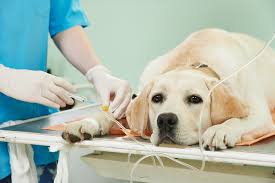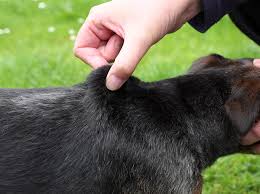Summer is here! And as it comes with many beautiful events, water, and glorious sun, it also comes with some incidents that aren’t very appealing.
One of those events is getting up to see your dog breathing heavily and sluggish. What should you do?
I have just been in this unfortunate event four days ago, and believe me, that’s why I wrote the blog (after my dog got better.)
Knowing that your dog is having a heatstroke is quite scary. However, don’t panic. I am here to help you and give you all the tips that you will need.
Heatstroke is dangerous and should be treated immediately. While there are many symptoms, dehydration and heavy panting are the most obvious symptoms.
Home Remedies can work for dogs who aren’t in severe condition. However, for a dehydrated dog, you must run to the vet.
Check our article to know all the details in depth!
What Does Heatstroke Mean? And Reasons For Its Occurrence

To be able to cure Heatstrokes, you must know what they are.
Heatstroke simply means overheating.
It happens mainly due to continuous exposure to a hot temperature that is more than what the body can bear.
Many people believe that heatstrokes are caused by the sun only. However, many dogs suffer from heatstrokes without being in the sun.
While the sun is considered the mean cause of raising the temperature, heatstrokes can also happen in the absence of sun if the temperature was too hot for a prolonged time.
Unfortunately, most of the time, pet owners are the people who are responsible for the Heatstrokes.
There are a few things that pet owners do, which cause the dogs to suffer from Heatstrokes:
- Leaving the dog in the backyard all day
- Trapping the dog in a locked car during the day
- Walking your dog during hot weather
- Playing with your dog severely in sweltering weather
- Not providing cold water for your dog
Those are some examples of what can cause a Heatstroke.
Notice that not all Heatstrokes are because of pet owners. Many times dogs just get heatstrokes because their body isn’t strong enough to tolerate this heat as in the case of my dog.
How Quickly Can Heatstroke Kill A Dog

To estimate how a heatstroke can kill a dog, it depends on several factors.
If your dog stays in the same conditions that caused a heatstroke, he might die pretty quickly.
That’s why scientists found that trapped dogs in a car, die in less than one hour! Can you imagine how quickly that is? Just one hour is enough for the dog to develop and die of heatstroke.
Same with dogs that stay on rooftops or in the backyards without a shaded place that they can use to hide. Those dogs are most likely to die in 2-3 hours, depending on the strength of the dog.
However, dogs that develop heatstroke will be at home (like my dog) and are unlikely to die. But we need to treat them because heatstroke’s can have side-effects as we covered earlier.
Some dogs can overcome heatstroke’s on their own and become super-healthy. However, in all the statistics, scientists found that moving your dog to a shaded place will reduce the severity of heatstroke’s by 63%
Providing cold water also helps to reduce heatstroke’s significantly!
Therefore, don’t take a chance because you will not know how long your dog can bear before being in a severe condition.
How To Prevent Heatstroke

As they say, prevention is better than treatment.
That’s why we recommend that we understand how to prevent heatstroke’s, so we would be in no need to treat them and protect our young fellows.
And as I already covered how the heatstroke happens in the dog’s body, I think you already have an idea of how we can prevent it from happening. But I have more tips to offer.
- If you feel that it’s a hot day, try to place some water on your dog before developing a heatstroke.
Making your dog always wet will help him defeat any heatstroke. - Generally, don’t play with your dog on a hot day. If your dog is energetic even on hot days, like mine, I would recommend playing some mental games instead.
Mental games are a great way to tire your dog without a lot of physical movements. Therefore, your dog won’t exert any of his energy. - A good trick in your dog’s diet is to provide him with some carbohydrates.
However, if your dog suffers from any chronic disease, then ignore this tip. Make sure to ask your vet before proceeding. - If you are in a tropical country, then ignore walking your dog even in the evening because heatstrokes can happen in the absence of the sun.
- Generally, when I feel it’s getting hot. I throw water on the ground wherever my dog is. Therefore, the lower body of the dog will always be wet.
- Coldwater is essential; make sure to change it regularly to make sure that it is always cold.
- Remove any dog’s clothes or socks, make sure your dog’s paw is always in the open air.
Remember, dogs’ paws are the only source of sweat, don’t block it. Try to make their hands wet regularly.
You can also replace your dog’s clothes with evaporative cooling vests for your dogs. These are vests that help in hot weather. - Give your dog fruits that are rich in water, such as watermelon. They are accommodating to keep your dog hydrated.
Try to avoid fatty food that makes your dog lethargic. Also, try to decrease the portions of your dog’s food to increase your dog’s activity or feed your dog at night only.
However, I don’t recommend this tip if your dog is on medicine or a medical condition. - Try to adjust your dog’s schedule before summer. Weather forecasts can tell us the hot days in advance.
If you can adjust your dog’s schedule to pee at night and in the early morning, this would be awesome.
However, if you can’t, then try to make your dog pee in a shaded place. If your dog knows the pee pads concept, they would be a great alternative to peeing outdoors.
Symptoms Of A Heatstroke

How can you know if your dog has heatstroke?
A funny story that happened to me years ago is that I thought my dog had a cardiac disease the first time she suffered from heatstroke. I don’t need to tell you how sarcastic were the vets of that.
The good thing is that the symptoms are the same across different dogs, and you would never find a dog suffering from heatstroke without those symptoms.
- Very high body temperature: The most apparent symptom is a body temperature higher than 103 F.
To measure the dog’s body temperature, you have to use a thermometer and measure it from the anal like babies.
If you can’t do it, you can sense the increase in his body temperature by putting your hand on his armpit. - Excessive Panting: Usually, the dog tries to cool himself down, which is a strong sign.
- Refusing to eat or drink: That’s a common reaction to heatstroke where the dog is trying to keep himself light by refusing to eat or drink. (This is pretty dangerous, it can lead to dehydration.)
- Dehydration: It’s a definite symptom that indicates that a dog is in severe heatstroke.
Dehydration could be determined through the dog’s gum if they looked very different then the dog is in dehydration already.
Also, a good test for dehydration is the dog’s skin. If it is not elastic as usual, then the dog lost a lot of water. - Vomiting and Diarrhea: On having symptoms like this, I recommend going to the nearest vet immediately.
Vomiting means that the dog is already struggling to keep his internal organs functioning well and that his kidney is suffering now. - Rapid Pulse: Place your hand on your dog’s chest, if you feel that his heart rate is too fast, and he is panting rapidly, he is suffering from heatstroke.
- Drooling: If your dog is drooling for no reason, it might be because of heatstroke.
Each one of these symptoms might be a symptom of another disease. However, heatstroke can be easily identified.
Heatstrokes must have 3 or 4 symptoms combined together. That way, it is pretty apparent that when a dog has heatstroke, you can identify him from a distance without putting your hand on him.
So if you find only one symptom such as vomiting, it might be due to another disease. Usually, any heatstroke will accompany an increase in temperature, panting, and rapid pulse.
This combination is definitely a heatstroke.
How To Treat A Heatstroke

Treatment of heatstroke depends on their severity.
If you have a vet nearby that is 5-8 mins away from home, then ignore home remedies and just run to him.
However, if the vet is not close to you, then please start treating it at home until the dog is better, then visit the vet.
Repeat these steps for at least: 30 minutes.
Generally, the treatment of heatstroke’s follows this procedure:
- Move out from the hot place
Move indoors and open the AC if you have one. Never try to treat a dog with heatstroke in the backyard.
If you are in the car, turn on the AC immediately and head to the nearest vet. - Use cold water
Start applying some cool (not cold) water on the dog’s ears, paws, armpits, head & lower belly area. Don’t use cold water as they tend to shrink the blood vessels, which may lead to a shock.
Therefore, some fresh tap water is going to be very good for your dog.
Make sure to re-keep applying water every 5 minutes. - If you have a fan, then put it in front of your dog.
The Breeze will help cool your dog down. - Stop everything when needed
Once your dog’s panting goes down and his heart impulse is returning to the regular rate, stop the fan and the water while keeping your dog indoors. - Don’t force your dog to do something that he doesn’t want to
Avoid playing with your dog and never force your dog to eat or drink. However, you can place some cold water in front of him, so he finds water whenever he wants. - Alcohols are excellent but don’t use them.
Avoid using alcohol. While alcohol can cool your dog, using alcohol is dangerous because if your dog licks alcohol, he might die. - Avoid human medicines.
Never give your dog any human, no matter what it is. Ask your vet before any medication. - Dehydration
Check for any signs of dehydration, keep track of his nose and gum. - Visit the vet
If your dog is getting better, then it’s time to go to the vet for check-ups.
If your dog became 100% better, then avoid going to the vet. In my case, I treat my dogs at home and don’t go to the vet unless I feel like my dogs aren’t feeling better.
Generally, if heatstroke continues for more than two days, you have to go to the vet.
However, if your dog is in a severe condition that he is dehydrated and has a body temperature higher than 41°c, run to the vet.
A dehydrated dog can die in less than an hour, don’t risk it. This type of severity might need NaCl solution or antibiotics to decrease body temperature.
However, if you observed the conditions early and moved fast, you will not reach this state.
Test Your Dog For Dehydration

You can test if your dog is dehydrated by doing a first skin test.
First, use your fingers to pinch a little piece of your dog’s skin. Dogs’ skin should be elastic and return back to its place immediately. If the skin returned back slowly, this means that the dog is dehydrated.
If the skin didn’t return back at all, this means that the dog is completely dehydrated.
Let me tell you that severe dehydration can kill a weak dog in under 20 mins. And in some cases, a dog can stay dehydrated for up to 2 days.
Whenever a dog gets dehydrated, you have to move pretty quickly.
However, dehydration should be handled by your vet. Any home remedies can’t place the conventional medicines that your vet suggests.
Why Do We Need To Treat Heatstroke’s?

Besides that, our dogs must be feeling miserable when their body temperature is high; why should we care about heatstroke’s? Can’t we just let them cure on their own?
Heatstroke’s are deadly, that’s true. But is that the only thing concerning about heatstroke’s? Being deadly?
Nope, heatstroke’s can damage the dog’s body if not treated. It can cause damage to the dog’s liver, kidney, heart, or skin. And it can also cause dog blindness.
So yes, heatstroke’s might not kill your dog. But they might damage his body if not treated.
Sweating Parts In Dogs’ Bodies

Dogs have fur all over their bodies. And what this means is that they can’t sweat!
Wait, do you know the importance of sweat?
All the human body can sweat, and this sweat helps in moderating the body’s temperature and getting rid of waste. Yes, like urine.
Dogs not being able to sweat means that their bodies can’t lose excess heat, which will increase their chance of getting heatstroke.
Their fur will protect them in winter, but will really be against them in summer.
However, there are a few parts that produce sweat. Those parts are either not covered by any fur or covered by a tiny quantity of coat.

Those parts are primarily the dog’s paws. Paws produce sweat, and they are the first part that we trigger when dealing with heatstroke’s.
Another standard part that isn’t covered by a lot of furs is the distance between the dog’s legs or the armpits.
While they don’t produce sweat, we trigger those parts to test the dog’s body temp without a thermometer or to help cool the dogs down artificially.
Do Dogs Depend On Sweat As Humans?
Nope, dogs don’t depend on sweat to cool them down.
Dogs have another system that can cool them down, which is through their tongue.
Have you ever asked yourself, why do dogs pant?
Dogs pant to cool themselves down! How is that possible?
Dogs’ tongue and lungs can evaporate heat. And therefore, dogs pant quickly and heavily when they have high body temps to evaporate more heat and regulate their bodies’ temperature.
That’s why vets always advise keeping cold water beside a dog who is having a heatstroke to help the dog drink more water. This water will go inside his body and gain some heat then evaporate.
Dogs have another superb system to lose some temperature. This system is an internal system.
This system is called Vasodilation, which is present in humans as well. The arteries and blood vessels widen to allow for more blood to flow, thus keeping the blood near the skin to expel heat from the internal organs.
This way, the heat can also be evaporated.
That’s why vets prohibit owners from giving their dogs a cold shower to fight heatstroke’s. Cold shower shrinks blood vessels and therefore damaging the dogs’ internal parts.
knowing the reason behind everything is how you can fight any disease/condition.
The Typical Dog’s Body Temperature
The average temperature for a dog’s body is higher than humans. It’s typically between 101 and 102.5 F (38.3 C. and 39.2 C.)
So what seems too high (102.5 F), is actually pretty typical for any dog.
However, a developing heatstroke dog will have a temperature around 105 F. Notice that I say developing.
Actually, 105 F isn’t considered a severe heatstroke yet, but it is regarded as a slight increase in the body’s temp. That’s why lots of vets recommend treating it at home.
However, if the dog’s body temp was 105 F for more than 2 or 3 days, you have to go the vet as this is abnormal.
Which Dog Breeds Are Most Likely To Suffer From Heatstroke?

Some breeds are born to live in Cold Weather, and some can tolerate hot weather.
While some breeds are at a very high risk of developing fast heatstroke, there are a few things to consider.
If you have a dog that generally can live in hot weather, but he was born in an icy area. You imported him to you in your tropical country, then this dog won’t tolerate warm temperatures at all.
Yes, genes are essential. However, the place of breeding is significant as well. That’s why I am firmly against exporting dogs to different countries on different continents as these dogs will suffer if temperate changes significantly.
However, as I said, some breeds -genetically- have a higher risk of developing heatstroke. Such dogs may have a dense fur like Golden Retrievers or a short nose that they are considered hard-breathing bread.
Some dogs tend to always be overweight like Saint Bernard, which might make them prone to heatstroke’s as well.
Some of the dogs that have a risk of developing heatstroke’s are:
- Bulldogs
- Pugs
- French Bulldogs
- Golden Retrievers
- Saint Bernard
- Akita’s
- Mastiffs
- Boxers
- Any toy dog with dense hair like Pekingese
Not because your dog wasn’t listed means he is safe. Every dog could suffer from heatstroke if he was exposed to one of the conditions that we mentioned before.
And not because your dog was listed means that he will definitely get a heatstroke. In fact, many Golden Retrievers never get a heatstroke because they were born into tropical countries. This is only relative, as I mentioned.
Why Do You Need To Know First Aid Tips?

Why bothering learning all that? You can just send the dog to vet after all.
Unfortunately, sometimes you must treat heatstrokes quickly before going to the vet, or otherwise, you will lose your dog.
If the vet is far away from you, you must first treat your dog to make him ready to ride.
And sometimes, if you really catch the symptoms of a heatstroke early, you wouldn’t need a vet at all and could just treat your dog at home.
In my case, I treated my dog at home in less than 2 hours, and I saved my visit to the vet. This is far better than giving your dog lots of medicine.
Disclaimer: We don’t recommend ignoring the vet’s advice at all. We are giving first aid tips that can help your dog based on certified organizations. A vet’s information is far more critical than first aid tips.
If you believe you couldn’t carry out the first aid procedures, then it’s best to ignore them and head directly to your vet. We don’t recommend giving your dog any medicine your vet’s advice.
That’s why all the remedies covered here are free of medicine and 100% safe on your dog.
FAQ
Here are some FAQ’s I found on the internet:
Unfortunately, it’s quite the opposite.
Smaller dogs are usually more susceptible to heatstroke’s. That’s because their body doesn’t contain much water, and losing it is very easy.
However, all dogs can get heatstroke’s. But, a short answer, no, large-breed dogs aren’t more susceptible to heatstroke.
It is dangerous for all dogs to lie under the sun, this can easily develop heatstroke.
Dark fur or black fur makes no difference than white fur. While some people think that white dogs aren’t very susceptible to heatstroke’s, but unfortunately, the dog’s color makes no difference.
Yes, yes, yes.
Leaving a dog in a hot car will develop heatstroke in less than 30 mins. Most likely, an hour is enough to kill a trapped dog.
It isn’t. If the AC is on, and the car is warm or cold from the inside with available water for your dog, then I will never do anything to the car.
However, If I found out a dog is trapped in a car without having a working AC, I would break the glass to get the dog out.
No, it is considered OK. I would prefer to leave him in a place where he could have some shade as well.
If you feel that 80 F isn’t hot for a human, then it won’t be hot for a dog.
However, providing cold water and a hideout for your dog will be very helpful.
My story:
What made me write this blog is that my dog has just been suffering from heatstroke.
The temperature raised up to 113 F, can you imagine that?
However, I realized that she is developing heatstroke from the moment that I woke up. I found her panting for no reason.
Despite having cold water, I expect this to happen. Mayla is usually a winter dog. Therefore, I had prepared some things to help me.
I have already put a towel in the freezer to use it whenever needed. So, I got it out and put it between Mayla’s legs.
I got tap water and put it all over my dog’s body and left her in front of the fan.
Two hours later, and her temperature dropped. However, she had been suffering from heatstroke in the form of waves. Meaning that she starts panting again in the night, then in the next morning.
After I treated her, and she became fine, I went to the vet to check on her. Luckily, she was in perfect health, and I needn’t worry.
That’s why I believe you should always be ready to treat your dog quickly.
Conclusion
Animals share with us the privilege of having a soul.
Pythagoras
Helping your dog get through any disease shows how responsible you are. No wonder you must be a wonderful person to open blogs on the internet and try to understand how to help your dog.
Heatstroke can be deadly, and handling them is essential. Remember never to ignore your vets’ advice, and if you can go to the vet quickly, then just do it.
Having a dog that goes around with you in every place is fantastic. My dog accompanies me to any place I go to. However, it will be unfair for your dog if you left him trapped in a hot car.
Don’t forget to check our latest articles! And share with us your experience with heatstroke!
Here is a list of our latest articles that you might be interested in!

